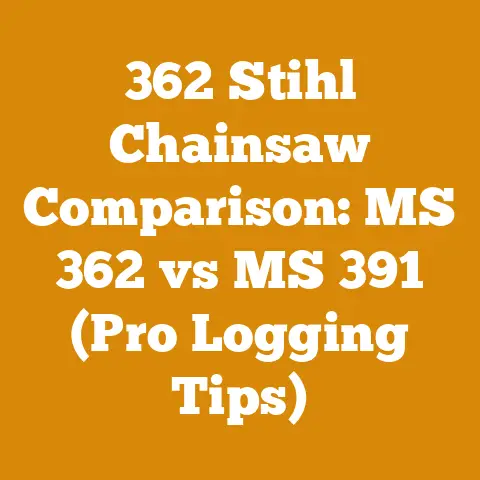Band Sawmill Blade Sharpener Guide (5 Pro Tips You Need)
I’ve seen it time and again: woodworkers and sawmill operators neglecting their band sawmill blades until they’re practically useless. It’s a common mistake, driven by the assumption that blades are a consumable item, easily replaced. But I’m here to tell you, a sharp blade is not just about efficient cutting; it’s about safety, lumber quality, and ultimately, saving you money. A dull blade forces your sawmill to work harder, increasing wear and tear, and producing uneven cuts that waste valuable timber. That’s why I’ve put together this guide, packed with pro tips to help you master the art of band sawmill blade sharpening.
Band Sawmill Blade Sharpener Guide: 5 Pro Tips You Need
Sharpening your band sawmill blades isn’t just a chore; it’s an investment in your operation. With the right techniques and tools, you can extend the life of your blades, improve your lumber quality, and increase your overall efficiency. Let’s dive into the essentials.
1. Understanding Your Blade: The Foundation of Sharpness
Before I even think about touching a sharpener, I make sure I understand the blade I’m working with. This isn’t just about knowing the length and width; it’s about understanding the blade’s profile, tooth geometry, and steel type.
- Tooth Geometry: The tooth geometry dictates how the blade cuts. There are different tooth patterns like raker, gullet, and hook angles. A deeper understanding of these angles is crucial for choosing the correct grinding wheel profile and sharpening technique.
- Blade Material: Blades are typically made from carbon steel, alloy steel, or bimetal. The type of steel affects the blade’s hardness, wear resistance, and the type of grinding wheel you should use. High-speed steel blades, for instance, require specialized grinding wheels.
- Blade Pitch (TPI): The number of teeth per inch (TPI) affects the cutting speed and finish. Blades with fewer teeth per inch are better for cutting thicker stock, while blades with more teeth are better for thinner stock and finer finishes. For example, a blade with 3 TPI is suitable for cutting logs, while a blade with 4-6 TPI is better for resawing lumber.
- Kerf: The kerf is the width of the cut made by the blade. Knowing the kerf is important for setting your sawmill properly and ensuring accurate cuts.
For example, I once worked with a batch of blades that were advertised as “general purpose,” but after closer inspection, I realized they had a shallow gullet design, making them unsuitable for cutting hardwoods. Trying to force them resulted in excessive heat buildup and premature dulling.
Takeaway: Always identify your blade’s specifications before sharpening. Consult the manufacturer’s documentation or use a magnifying glass to examine the tooth geometry.
2. Choosing the Right Sharpener: Manual vs. Automatic
The market offers a variety of band sawmill blade sharpeners, ranging from manual hand crank models to sophisticated CNC-controlled automatic machines. The best choice for you depends on your budget, the volume of blades you need to sharpen, and your desired level of precision.
- Manual Sharpeners: These are the most affordable option, suitable for small-scale operations or hobbyists. They require more skill and time, but can produce excellent results with practice.
- Automatic Sharpeners: These machines automate the sharpening process, offering greater speed, consistency, and precision. They are ideal for larger sawmills or operations that require frequent blade sharpening.
- CNC Sharpeners: These are the most advanced sharpeners, offering programmable control over all sharpening parameters. They are capable of producing the highest quality results, but also come with the highest price tag.
I remember starting out with a basic hand crank sharpener. It was slow and tedious, but it taught me the fundamentals of blade sharpening and helped me develop a feel for the process. As my operation grew, I eventually upgraded to an automatic sharpener, which significantly increased my efficiency.
Takeaway: Consider your needs and budget when choosing a sharpener. Start with a simpler model if you’re new to blade sharpening, and upgrade as your operation grows.
3. Mastering the Sharpening Process: A Step-by-Step Guide
Sharpening a band sawmill blade is a meticulous process that requires patience and attention to detail. Here’s a step-by-step guide to help you get started:
- Preparation:
- Clean the Blade: Use a wire brush and solvent to remove any resin, sawdust, or rust from the blade. A clean blade ensures better grinding wheel contact and prevents contamination. I’ve found that a citrus-based degreaser works wonders for removing stubborn resin buildup.
- Inspect the Blade: Carefully examine the blade for any cracks, broken teeth, or other damage. Discard any blades that are severely damaged, as they can be dangerous to use. Use a magnifying glass to closely inspect the teeth for any signs of wear or damage.
- Set Up Your Sharpener: Ensure your sharpener is properly calibrated and adjusted according to the manufacturer’s instructions. This includes setting the correct grinding wheel angle, feed rate, and depth of cut. Use a dial indicator to precisely align the grinding wheel with the blade.
- Grinding:
- Choose the Right Grinding Wheel: Select a grinding wheel that is appropriate for the type of steel your blade is made from. Use a CBN (Cubic Boron Nitride) wheel for high-speed steel blades and an aluminum oxide wheel for carbon steel blades. The grit size of the wheel also matters. A finer grit wheel (e.g., 180-220 grit) is better for sharpening, while a coarser grit wheel (e.g., 80-120 grit) is better for grinding.
- Grind Each Tooth Consistently: Maintain a consistent grinding pressure and feed rate to ensure uniform sharpening. Avoid overheating the blade, as this can weaken the steel. Use a coolant to dissipate heat and prevent the blade from warping. I prefer using a water-based coolant, as it is environmentally friendly and effective.
- Follow the Original Tooth Profile: Pay close attention to the original tooth profile and try to replicate it as closely as possible. Avoid grinding away too much material, as this can shorten the life of the blade. Use a template or guide to help you maintain the correct tooth profile.
- Finishing:
- Deburr the Blade: Use a fine file or deburring tool to remove any burrs or sharp edges from the blade. This will prevent the blade from snagging on the wood and improve the cut quality. A small diamond file is ideal for deburring band sawmill blades.
- Set the Tooth: After sharpening, you may need to reset the tooth to ensure proper clearance. Use a tooth setter to accurately and consistently set each tooth. The amount of set depends on the type of wood you are cutting. Softer woods require less set than harder woods.
- Inspect the Finished Blade: Carefully inspect the sharpened blade to ensure that all teeth are uniform and sharp. Use a magnifying glass to check for any imperfections. Run your finger (carefully!) along the teeth to feel for sharpness.
Takeaway: Practice makes perfect. Start with a few scrap blades to get a feel for the process before sharpening your good blades.
4. Optimizing Grinding Wheel Selection: The Key to a Perfect Edge
The grinding wheel is the heart of the sharpening process. Choosing the right wheel is crucial for achieving a perfect edge and extending the life of your blades.
- Wheel Material: As I mentioned earlier, CBN wheels are ideal for high-speed steel blades, while aluminum oxide wheels are better for carbon steel blades. CBN wheels are harder and more durable than aluminum oxide wheels, but they are also more expensive.
- Grit Size: The grit size of the wheel determines the fineness of the edge. A finer grit wheel (e.g., 180-220 grit) produces a sharper edge, while a coarser grit wheel (e.g., 80-120 grit) removes material faster. I typically use a 220-grit wheel for sharpening and a 120-grit wheel for grinding down damaged teeth.
- Wheel Shape: The shape of the wheel should match the tooth profile of your blade. Common wheel shapes include straight, radiused, and conical. Use a radiused wheel for sharpening gullets and a conical wheel for sharpening tooth faces.
- Wheel Dressing: Regularly dress your grinding wheel to remove any buildup of metal particles and maintain its shape. Use a dressing stick or diamond dresser to clean and reshape the wheel. A dull or clogged grinding wheel will produce a poor-quality edge and can damage your blade.
I once made the mistake of using an aluminum oxide wheel on a high-speed steel blade. The wheel quickly wore down, and the blade overheated, resulting in a dull and uneven edge. It was a costly lesson in the importance of choosing the right grinding wheel.
Takeaway: Invest in high-quality grinding wheels and take the time to select the right wheel for your blade type and sharpening needs.
5. Troubleshooting Common Sharpening Problems: Expert Tips
Even with the best equipment and techniques, you may encounter problems during the sharpening process. Here are some common issues and how to resolve them:
- Blade Overheating: Overheating can weaken the steel and cause the blade to warp. Use a coolant, reduce the grinding pressure, and increase the feed rate to prevent overheating.
- Uneven Sharpening: Uneven sharpening can result in a blade that cuts poorly or vibrates excessively. Ensure your sharpener is properly calibrated and that you are maintaining a consistent grinding pressure and feed rate.
- Grinding Wheel Clogging: Clogging can reduce the wheel’s cutting efficiency and cause it to overheat. Regularly dress your grinding wheel to remove any buildup of metal particles.
- Tooth Breakage: Excessive grinding pressure or a dull grinding wheel can cause teeth to break. Use a sharp grinding wheel and avoid applying too much pressure.
- Inconsistent Tooth Set: Inconsistent tooth set can cause the blade to wander or cut unevenly. Use a tooth setter to accurately and consistently set each tooth.
I remember one instance where I was struggling with a blade that kept wandering during cutting. After a thorough inspection, I discovered that the tooth set was inconsistent. I re-set all the teeth using a precision tooth setter, and the problem was solved.
Takeaway: Don’t get discouraged if you encounter problems. Take the time to diagnose the issue and implement the appropriate solution.
Measuring Sharpness: Tools and Techniques
How do you know if your blade is truly sharp? It’s not just about feeling the edge; it’s about quantifiable measurements.
- Magnification: Use a magnifying glass or microscope to examine the cutting edge. A sharp edge will appear clean and crisp, while a dull edge will be rounded or chipped. I use a 10x magnifying glass to inspect my blades after sharpening.
- Test Cut: Make a test cut in a piece of scrap wood. A sharp blade will cut smoothly and cleanly, while a dull blade will tear or burn the wood. Use the same type of wood you typically cut for the most accurate results.
- Cutting Speed: Monitor the cutting speed of your sawmill. A sharp blade will cut faster and more efficiently than a dull blade. Keep a log of your cutting times to track blade performance.
- Power Consumption: Monitor the power consumption of your sawmill. A sharp blade will require less power to cut than a dull blade. Use a power meter to measure the power consumption during cutting.
Takeaway: Use a combination of visual inspection and performance testing to assess the sharpness of your blades.
Safety First: Protecting Yourself During Sharpening
Sharpening band sawmill blades involves working with sharp objects and potentially hazardous machinery. It’s essential to prioritize safety at all times.
- Wear Safety Glasses: Always wear safety glasses to protect your eyes from flying debris.
- Wear Gloves: Wear gloves to protect your hands from sharp edges and grinding wheel dust. I prefer using cut-resistant gloves for added protection.
- Use a Dust Mask: Use a dust mask to protect your lungs from grinding wheel dust.
- Keep Your Work Area Clean: Keep your work area clean and free of clutter to prevent accidents.
- Follow Manufacturer’s Instructions: Always follow the manufacturer’s instructions for operating your sharpener and handling grinding wheels.
- Disconnect Power: Always disconnect the power to your sharpener before performing any maintenance or adjustments.
I once witnessed a colleague who wasn’t wearing safety glasses get a metal sliver in his eye while sharpening a blade. It was a painful reminder of the importance of safety precautions.
Takeaway: Never compromise on safety. Always wear the appropriate personal protective equipment and follow safe operating procedures.
The Economics of Sharpness: Saving Money in the Long Run
Sharpening your own band sawmill blades may seem like a time-consuming task, but it can save you significant money in the long run.
- Extended Blade Life: Sharpening your blades regularly can extend their life by several times. This reduces the frequency of blade replacements and saves you money on blade purchases.
- Improved Cutting Efficiency: A sharp blade cuts faster and more efficiently, reducing the amount of time and energy required to process lumber.
- Reduced Sawmill Wear and Tear: A sharp blade puts less strain on your sawmill, reducing wear and tear and extending the life of your equipment.
- Improved Lumber Quality: A sharp blade produces smoother and more accurate cuts, resulting in higher quality lumber and less waste.
I’ve calculated that sharpening my own blades saves me approximately 50% compared to outsourcing the sharpening or constantly buying new blades. The initial investment in a sharpener pays for itself in a relatively short period.
Takeaway: Sharpening your own blades is a cost-effective way to improve your lumber quality, reduce your operating costs, and extend the life of your equipment.
Alternative Sharpening Methods: When to Seek Professional Help
While I advocate for sharpening your own blades, there are times when seeking professional help is the best option.
- Severely Damaged Blades: Blades with broken teeth, cracks, or significant damage may require specialized repair techniques that are beyond the capabilities of most DIY sharpeners.
- Complex Tooth Profiles: Blades with complex tooth profiles or exotic materials may require specialized grinding wheels and sharpening techniques.
- Lack of Experience: If you are new to blade sharpening and lack the necessary skills or experience, it’s best to seek professional help to avoid damaging your blades or injuring yourself.
I once had a blade that was severely warped due to overheating. I attempted to straighten it myself, but ended up making the problem worse. I eventually took it to a professional blade repair shop, where they were able to restore it to its original condition.
Takeaway: Know your limitations. Don’t hesitate to seek professional help when necessary.
Blade Storage: Protecting Your Investment
Proper blade storage is essential for preventing rust, corrosion, and damage. Here are some tips for storing your band sawmill blades:
- Clean and Dry Blades: Before storing your blades, clean them thoroughly and dry them completely.
- Apply a Rust Inhibitor: Apply a rust inhibitor to protect the blades from corrosion. I use a light coat of oil or a commercially available rust inhibitor.
- Store Blades in a Dry Place: Store your blades in a dry, well-ventilated place. Avoid storing them in damp or humid environments.
- Protect Blades from Physical Damage: Protect your blades from physical damage by storing them in a protective case or rack.
- Label Blades: Label your blades with their specifications and sharpening history to help you keep track of their performance.
I store my blades in a custom-built rack that keeps them organized and protected from damage. I also keep a logbook of each blade’s sharpening history, which helps me track their performance and identify any potential problems.
Takeaway: Proper blade storage is a simple but effective way to extend the life of your blades and protect your investment.
The Future of Blade Sharpening: Technological Advancements
The field of blade sharpening is constantly evolving, with new technologies and techniques emerging all the time.
- CNC Sharpeners: CNC sharpeners are becoming more affordable and accessible, offering greater precision and automation.
- Laser Sharpening: Laser sharpening is a promising new technology that uses lasers to precisely remove material from the blade.
- AI-Powered Sharpeners: AI-powered sharpeners are being developed that can automatically adjust sharpening parameters based on blade type, material, and cutting conditions.
I’m excited about the potential of these new technologies to revolutionize the blade sharpening process and make it more efficient, accurate, and accessible.
Takeaway: Stay informed about the latest advancements in blade sharpening technology to stay ahead of the curve and optimize your operation.
Conclusion: The Art and Science of Sharpness
Sharpening band sawmill blades is both an art and a science. It requires a combination of knowledge, skill, and attention to detail. By following the pro tips in this guide, you can master the art of blade sharpening and reap the rewards of improved lumber quality, reduced operating costs, and extended equipment life. Remember, a sharp blade is not just about efficient cutting; it’s about safety, precision, and maximizing the value of your timber. Now, go sharpen those blades and get back to sawing!






